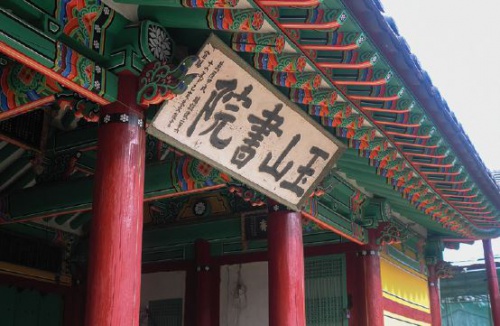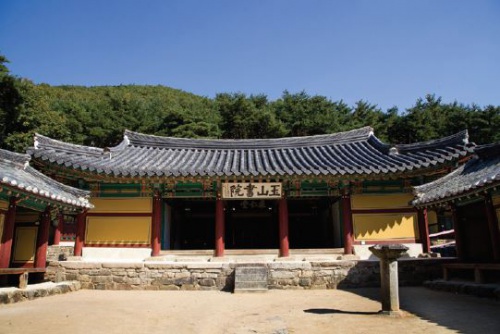"Korea's Religious Places - 2.4.2 Oksan Seowon (Gyeongju, Gyeongsangbuk-do)"의 두 판 사이의 차이
(새 문서: ==Oksan Seowon (Gyeongju, Gyeongsangbuk-do)== Built at about the same time as the Dosan Seowon, the Oksan Seowon is dedicated to the memory of Yi Eon-jeok (1491–1553). Yi was a gre...) |
잔글 (→Oksan Seowon (Gyeongju, Gyeongsangbuk-do)) |
||
| 1번째 줄: | 1번째 줄: | ||
==Oksan Seowon (Gyeongju, Gyeongsangbuk-do)== | ==Oksan Seowon (Gyeongju, Gyeongsangbuk-do)== | ||
| − | Built at about the same time as the Dosan Seowon, the Oksan Seowon is dedicated to the memory of Yi Eon-jeok (1491–1553). Yi was a great scholarly innovator in the interpretation of Zhu Xi’s Neo-Confucianism. Many of his ideas exercised great influence on Yi Hwang, who came along a few years later. The Oksan Seowon took nearly nineteen years after the death of Yi Eon-jeok to get built (in 1573). The Dosan Seowon was built three years after Yi Hwang died (in 1574). The late sixteenth century saw the proliferation of seowon, and the rate only increased in the seventeenth century. | + | Built at about the same time as the Dosan Seowon, the Oksan Seowon is dedicated to the memory of Yi Eon-jeok (1491–1553). Yi was a great scholarly innovator in the interpretation of Zhu Xi’s Neo-Confucianism. Many of his ideas exercised great influence on Yi Hwang, who came along a few years later. The Oksan Seowon took nearly nineteen years after the death of Yi Eon-jeok to get built (in 1573). The Dosan Seowon was built three years after Yi Hwang died (in 1574). The late sixteenth century saw the proliferation of ''seowon'', and the rate only increased in the seventeenth century. |
| 10번째 줄: | 10번째 줄: | ||
| − | The Oksan Seowon was built in a beautiful setting in a deep wood on the banks of a stream that cuts through a beautiful rock formation. The seowon is next to a small cascade in the stream that lends credence to the unwritten rule that a seowon must be built in a beautiful natural setting. | + | The Oksan Seowon was built in a beautiful setting in a deep wood on the banks of a stream that cuts through a beautiful rock formation. The ''seowon'' is next to a small cascade in the stream that lends credence to the unwritten rule that a seowon must be built in a beautiful natural setting. |
| − | The seowon, typical of all private academies, has two main buildings, one for teaching and one for ceremonies. Here at the Oksan Seowon, the building for teaching is called the Guindang, meaning “the building for the search of humaneness.” Humaneness (仁, in) is the heart of Confucianism. The Sino-Korean character in (ren in Chinese) is sometimes translated as human-heartedness. It means the relationship between two people and implies all of the moral relationships of Confucianism: king to subject, parent to child, husband to wife, senior to junior, and friend to friend. The hall for ceremonies also has the character in in it; it is the Cheinmyo, the shrine for the embodiment of humaneness. Humaneness is learned (sought) in the school and practiced (embodied) in the hall of ceremonies. | + | The ''seowon'', typical of all private academies, has two main buildings, one for teaching and one for ceremonies. Here at the Oksan Seowon, the building for teaching is called the Guindang, meaning “the building for the search of humaneness.” Humaneness (仁, ''in'') is the heart of Confucianism. The Sino-Korean character in (''ren'' in Chinese) is sometimes translated as ''human-heartedness''. It means the relationship between two people and implies all of the moral relationships of Confucianism: king to subject, parent to child, husband to wife, senior to junior, and friend to friend. The hall for ceremonies also has the character ''in'' in it; it is the Cheinmyo, the shrine for the embodiment of humaneness. ''Humaneness'' is learned (sought) in the school and practiced (embodied) in the hall of ceremonies. |
| − | Korean officials are preparing a proposal to have several of the major seowon made into UNESCO World Heritage Sites, but the Oksan Seowon has already been so designated because it was included in the UNESCO inscription of the Yangdong and Hahoe traditional villages. In 2010, these two villages were recognized by the UNESCO organization, and although located about eight kilometers from Yangdong Village itself, the UNESCO proclamation included the seowon as part of the village. This is also true for the Byeongsan Seowon (see p72), located four kilometers from Hahoe Village. Therefore, the Oksan Seowon and the Byeongsan Seowon are already internationally recognized ahead of the other seowon that are in the application procedure at the time of this writing. | + | Korean officials are preparing a proposal to have several of the major ''seowon'' made into UNESCO World Heritage Sites, but the Oksan Seowon has already been so designated because it was included in the UNESCO inscription of the Yangdong and Hahoe traditional villages. In 2010, these two villages were recognized by the UNESCO organization, and although located about eight kilometers from Yangdong Village itself, the UNESCO proclamation included the ''seowon'' as part of the village. This is also true for the Byeongsan Seowon (''see'' p72), located four kilometers from Hahoe Village. Therefore, the Oksan Seowon and the Byeongsan Seowon are already internationally recognized ahead of the other ''seowon'' that are in the application procedure at the time of this writing. |
2017년 1월 17일 (화) 23:34 판
Oksan Seowon (Gyeongju, Gyeongsangbuk-do)
Built at about the same time as the Dosan Seowon, the Oksan Seowon is dedicated to the memory of Yi Eon-jeok (1491–1553). Yi was a great scholarly innovator in the interpretation of Zhu Xi’s Neo-Confucianism. Many of his ideas exercised great influence on Yi Hwang, who came along a few years later. The Oksan Seowon took nearly nineteen years after the death of Yi Eon-jeok to get built (in 1573). The Dosan Seowon was built three years after Yi Hwang died (in 1574). The late sixteenth century saw the proliferation of seowon, and the rate only increased in the seventeenth century.
- Oksan Seowon
The Oksan Seowon was built in a beautiful setting in a deep wood on the banks of a stream that cuts through a beautiful rock formation. The seowon is next to a small cascade in the stream that lends credence to the unwritten rule that a seowon must be built in a beautiful natural setting.
The seowon, typical of all private academies, has two main buildings, one for teaching and one for ceremonies. Here at the Oksan Seowon, the building for teaching is called the Guindang, meaning “the building for the search of humaneness.” Humaneness (仁, in) is the heart of Confucianism. The Sino-Korean character in (ren in Chinese) is sometimes translated as human-heartedness. It means the relationship between two people and implies all of the moral relationships of Confucianism: king to subject, parent to child, husband to wife, senior to junior, and friend to friend. The hall for ceremonies also has the character in in it; it is the Cheinmyo, the shrine for the embodiment of humaneness. Humaneness is learned (sought) in the school and practiced (embodied) in the hall of ceremonies.
Korean officials are preparing a proposal to have several of the major seowon made into UNESCO World Heritage Sites, but the Oksan Seowon has already been so designated because it was included in the UNESCO inscription of the Yangdong and Hahoe traditional villages. In 2010, these two villages were recognized by the UNESCO organization, and although located about eight kilometers from Yangdong Village itself, the UNESCO proclamation included the seowon as part of the village. This is also true for the Byeongsan Seowon (see p72), located four kilometers from Hahoe Village. Therefore, the Oksan Seowon and the Byeongsan Seowon are already internationally recognized ahead of the other seowon that are in the application procedure at the time of this writing.

